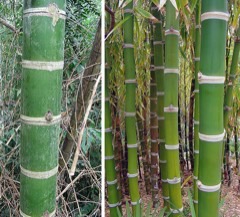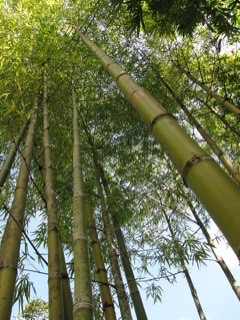 |
|
Dick Culbert on Wikimedia.org |
 |
| Forest Starr & Kim Starr starrenvironmental.com |
Translate this page:
Summary
Physical Characteristics

 Guadua angustifolia is an evergreen Bamboo growing to 25 m (82ft) by 5 m (16ft) at a fast rate.
Guadua angustifolia is an evergreen Bamboo growing to 25 m (82ft) by 5 m (16ft) at a fast rate.
See above for USDA hardiness. It is hardy to UK zone 10. The flowers are pollinated by Wind.
Suitable for: light (sandy), medium (loamy) and heavy (clay) soils and prefers well-drained soil. Suitable pH: mildly acid and neutral soils. It can grow in semi-shade (light woodland) or no shade. It prefers moist soil and can tolerate drought.
UK Hardiness Map
US Hardiness Map
Synonyms
Arundarbor guadua (Humb. & Bonpl.) Kuntze. Bambos aculeata (Rupr. ex E.Fourn.) Hitchc. Bambusa aculeata (E.Fourn.) Hitchc. Bambusa guadua Bonpl. Bambusa inermis Caldas. Guadua aculeata E.Fourn. Guadua inermis E.Fourn. Guadua intermedia E.Fourn. Nastus guadua (Kunth) Spreng.
Plant Habitats
Edible Uses
No evidence the shoots are edible.
References More on Edible Uses
Medicinal Uses
Plants For A Future can not take any responsibility for any adverse effects from the use of plants. Always seek advice from a professional before using a plant medicinally.
None Known
References More on Medicinal Uses
The Bookshop: Edible Plant Books
Our Latest books on Perennial Plants For Food Forests and Permaculture Gardens in paperback or digital formats.

Edible Tropical Plants
Food Forest Plants for Hotter Conditions: 250+ Plants For Tropical Food Forests & Permaculture Gardens.
More

Edible Temperate Plants
Plants for Your Food Forest: 500 Plants for Temperate Food Forests & Permaculture Gardens.
More

More Books
PFAF have eight books available in paperback and digital formats. Browse the shop for more information.
Shop Now
Other Uses
Biomass Fodder Furniture Paper Plant support Wood
Furniture & crafts work, raw construction material, panels (plywood, laminates, floors), bio-energy industry, musical instruments, houses, etc. Guadua meets the International Building Code (IBC) . Too big for pots and containers. A good ornamental bamboo. Carbon Farming Solutions - Industrial Crop: biomass (Crops grown for non-food uses. Industrial crops provide resources in three main categories: materials, chemicals, and energy. Traditional materials include lumber and thatch, paper and cardboard, and textiles) [1-1]. Fodder: bank.
Special Uses
Carbon Farming Food Forest
References More on Other Uses
Cultivation details
Fodder: Bank Industrial Crop: Biomass Management: Managed Multistem Regional Crop
Climate: subtropical to tropical. Humidity: humid. Minimum temperature tolerance: -2°C. Prefers tropical or subtropical climates, but still tolerates some frost. Full sun. Moist, well drained soil. Soil pH requirements: 5.6 (acidic) to 7.5 (neutral). Normal growing conditions in the central region of the Andes, between 900 and 1,600 meters above sea level, at temperatures between 20° and 26° Centigrade, rainfalls of 2,000 - 2,500 mm/year, a relative humidity of 75 - 85% and on alluvial soils that are rich in volcanic ash with a moderate fertility and good drainage. Carbon Farming Solutions - Cultivation: regional crop. Management: managed multistem (Describes the non-destructive management systems that are used in cultivation) [1-1].
Carbon Farming
-
Fodder: Bank
Fodder banks are plantings of high-quality fodder species. Their goal is to maintain healthy productive animals. They can be utilized all year, but are designed to bridge the forage scarcity of annual dry seasons. Fodder bank plants are usually trees or shrubs, and often legumes. The relatively deep roots of these woody perennials allow them to reach soil nutrients and moisture not available to grasses and herbaceous plants.
-
Industrial Crop: Biomass
Three broad categories: bamboos, resprouting woody plants, and giant grasses. uses include: protein, materials (paper, building materials, fibers, biochar etc.), chemicals (biobased chemicals), energy - biofuels
-
Management: Managed Multistem
Regularly removing some multiple stems. A non-A non-destructive management systems maintaining the soil organic carbon.
-
Regional Crop
These crops have been domesticated and cultivated regionally but have not been adopted elsewhere and are typically not traded globally, Examples in this broad category include perennial cottons and many nuts and staple fruits.
References Carbon Farming Information and Carbon Sequestration Information
Temperature Converter
Type a value in the Celsius field to convert the value to Fahrenheit:
Fahrenheit:
The PFAF Bookshop
Plants For A Future have a number of books available in paperback and digital form. Book titles include Edible Plants, Edible Perennials, Edible Trees,Edible Shrubs, Woodland Gardening, and Temperate Food Forest Plants. Our new book is Food Forest Plants For Hotter Conditions (Tropical and Sub-Tropical).
Shop Now
Plant Propagation
Cuttings
Other Names
If available other names are mentioned here
Columbian Giant Thorny, Giant Columbian bamboo, Columbian Timber Bamboo
Native Range
SOUTHERN AMERICA: Venezuela, Colombia, Ecuador,
Weed Potential
Right plant wrong place. We are currently updating this section.
Please note that a plant may be invasive in one area but may not in your area so it's worth checking.
None Known
Conservation Status
IUCN Red List of Threatened Plants Status : This taxon has not yet been assessed

Growth: S = slow M = medium F = fast. Soil: L = light (sandy) M = medium H = heavy (clay). pH: A = acid N = neutral B = basic (alkaline). Shade: F = full shade S = semi-shade N = no shade. Moisture: D = dry M = Moist We = wet Wa = water.
Now available:
Food Forest Plants for Mediterranean Conditions
350+ Perennial Plants For Mediterranean and Drier Food Forests and Permaculture Gardens.
[Paperback and eBook]
This is the third in Plants For A Future's series of plant guides for food forests tailored to
specific climate zones. Following volumes on temperate and tropical ecosystems, this book focuses
on species suited to Mediterranean conditions—regions with hot, dry summers and cool, wet winters,
often facing the added challenge of climate change.
Read More
Expert comment
Author
Kunth
Botanical References
Links / References
For a list of references used on this page please go here
Readers comment
| Add a comment |
|
If you have important information about this plant that may help other users please add a comment or link below. Only comments or links that are felt to be directly relevant to a plant will be included. If you think a comment/link or information contained on this page is inaccurate or misleading we would welcome your feedback at [email protected]. If you have questions about a plant please use the Forum on this website as we do not have the resources to answer questions ourselves.
* Please note: the comments by website users are not necessarily those held by PFAF and may give misleading or inaccurate information.
To leave a comment please Register or login here All comments need to be approved so will not appear immediately.
|
Subject : Guadua angustifolia
|
|
|
|